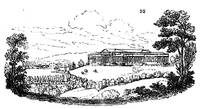344. The palace, or landhaus (country-house), as it is called, of Rosenstein, is beautifully situated on rising grounds in the neighbourhood of Stuttgard, with the royal palace in which, it communicates by a straight road, three miles in length, through a mixed style of landscape. The palace is from the designs of Salucci, and is characterised by an elegant simplicity of style. In the view of the entrance front (fig. 90.), the chapel of Rothenberg is seen from the summit of the hill of that name. This chapel (fig. 91.) was built by the present king, at the request of his first wife, as a burial-place for her remains. In the view of the garden front (fig. 92.) will be seen, to the left, the valley of the Neckar; in the foreground, orchards; and in the distance, hills covered with vines. It is utterly impossible to give an idea of the great beauty of the situation of the palace at Rosenstein otherwise than by very large views. The hills and mountains which every where surround it, all of the most varied and beautiful forms, and at the most suitable distances for effect; the lower ranges covered with fruit trees, cottages, and vineyards; and the higher summits bare or clothed with forests; that noble river the Neckar, at the bottom of a steep bank, immediately under the eye; its fertile valley, with the ancient village of Constadt on one side of the palace; on the other, at some distance, the city of Stuttgard; and in every direction the parklike style of the country, form altogether one of the noblest situations for a princely residence which we have any where seen. So admirably do the orchards, vineyards, and plantations of adjoining proprietors harmonise with the park, that it seemed to us, in 1828, as if the whole kingdom of Wirtemberg had joined together in forming a park and palace for their king. This seeming effect, however, we found to be very different from the reality; for, on conversing with persons of different ranks, we found, that though the beauty of the situation, and the merits of Signor Salucci, the architect, and M. Bosch, the landscape-gardener, were fully allowed, yet that the palace was considered altogether unnecessary for a king who had already so many, and as much too costly a fabric for the ruler of so small a kingdom. As compared with an English palace, that of Rosenstein has considerable defects in the windows and in the interior finishings. The windows are in the French manner; but, instead of opening from the bottom to the top, they have a cross mullion at about two thirds of their height, all the glass above which is fixed. In winter, the only mode of giving air, without filling the rooms with the external atmosphere, is by opening single panes; and even in summer, the rooms can never be so thoroughly ventilated as if the windows opened from the top. The timber-work, and the hinges and fastenings of these windows, would be reckoned very clumsy in Britain, and the glass is wavy, blistered, and not clear. in such a palace, in England, two large panes of plate-glass would have filled each window; and the two sashes would have been hung, instead of opening inwards. The mode of heating by stoves ought not to be objected to in Germany, nevertheless in a king's palace, a system of flues in the floors and walls might have been advantageously substituted for it. The plaster-work is so very inferior to that of an ordinary house in England, that to an Englishman it gives the idea of poverty and meanness; but the floors, some of which are inlaid, are good. We say nothing of the furnishing of this palace, because that, when we saw it, was not completed. The grounds round the palace of Rosenstein contain between 200 and 300 acres, and the surface may be described as that of a flattish hemispherical table-land, laid out in imitation of the English manner; but it is more formal than would have been the case in England. The planting is done in the manner of Sckell, and Lenne of Berlin: combining forest trees with fruit trees, and shrubs with flowers; and always having one sort prevailing in one place. In this garden there are no Scotch pines, spruce firs, or birches: the reason is, as we were informed, that the king, when in Russia, and courting his first wife, was so disgusted with the prevalence of these trees, in the neighbourhood of St. Petersburg, and the absence of almost every other kind, that he positively forbade their introduction at Rosenstein.





